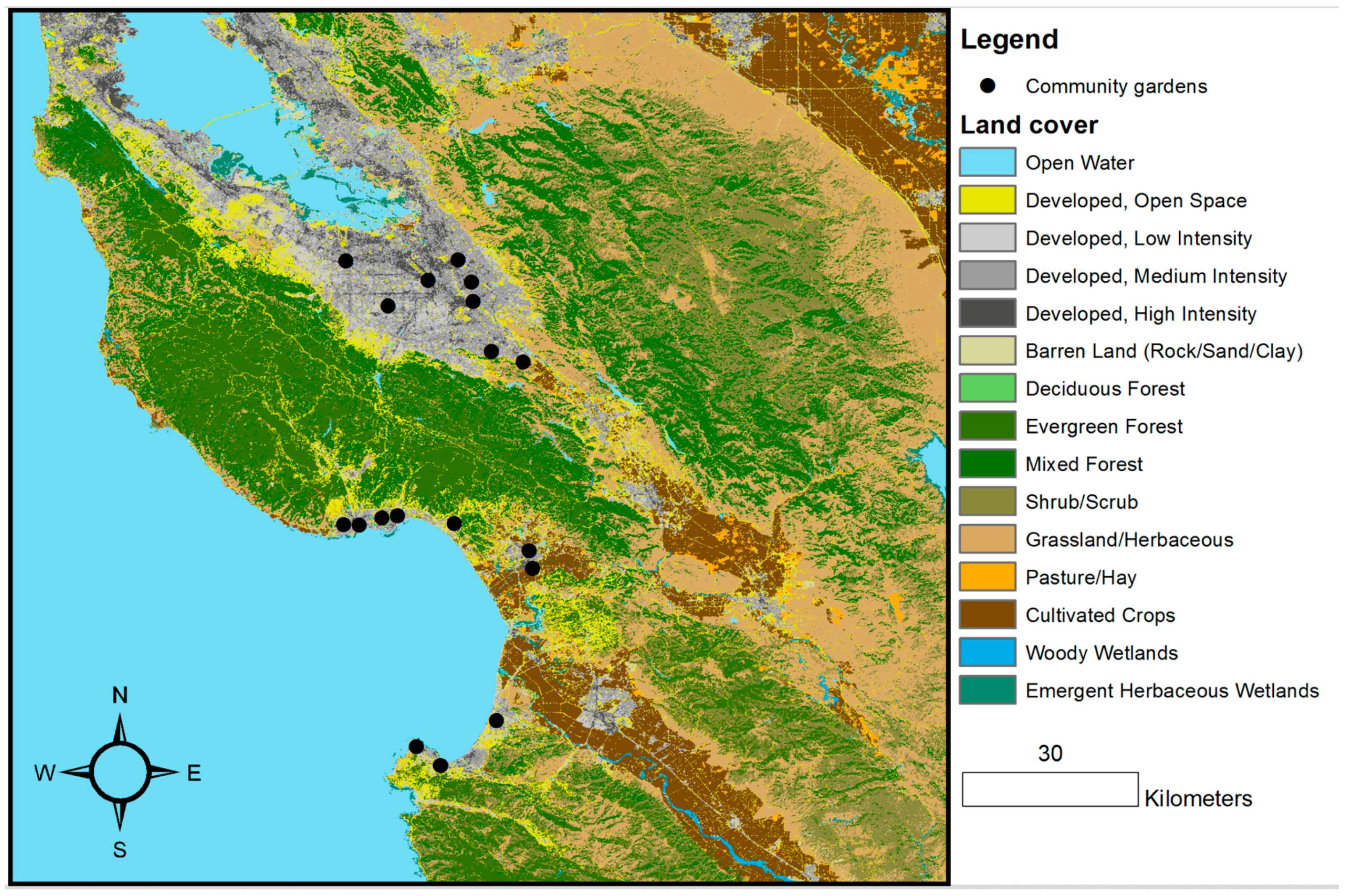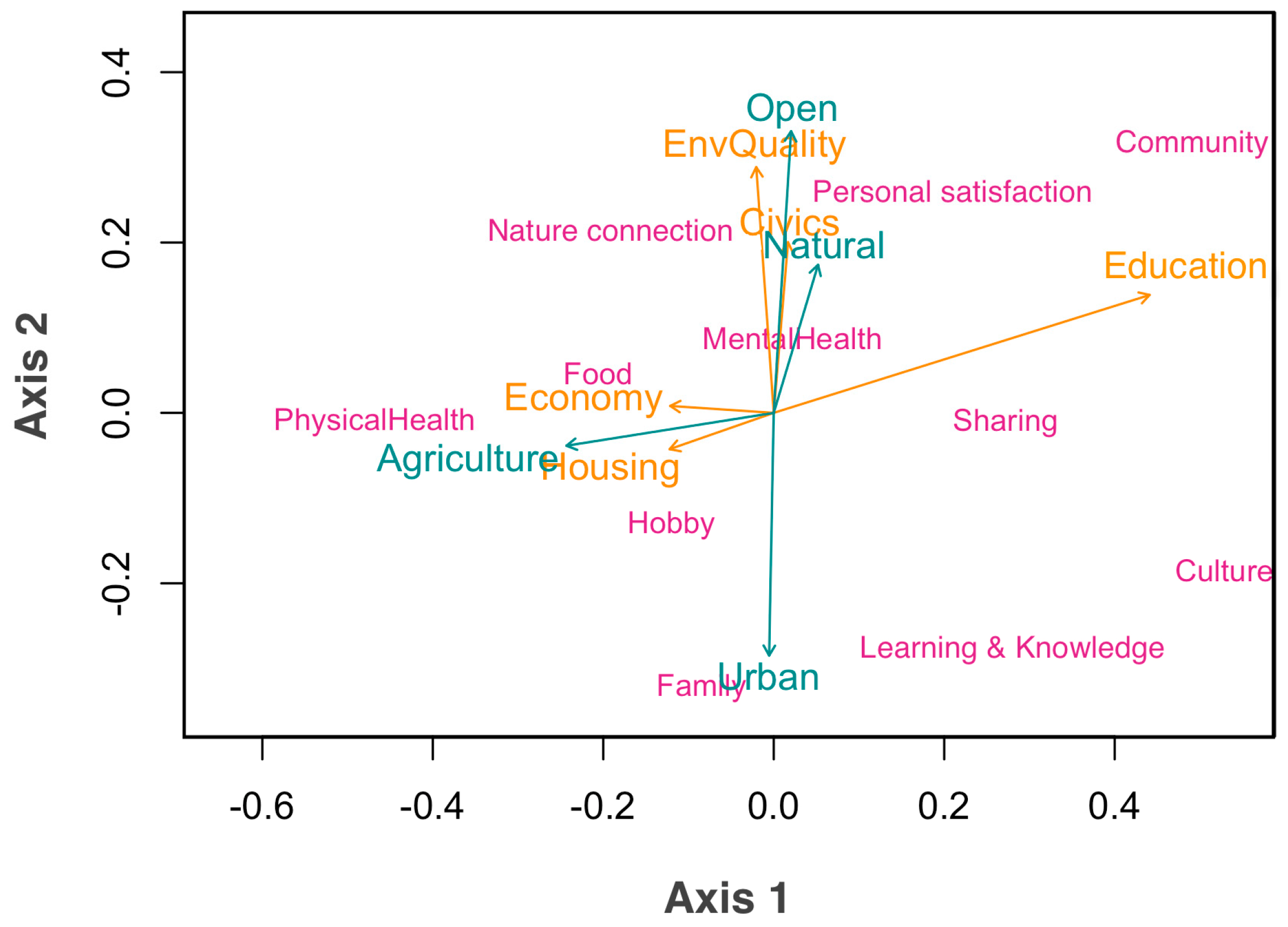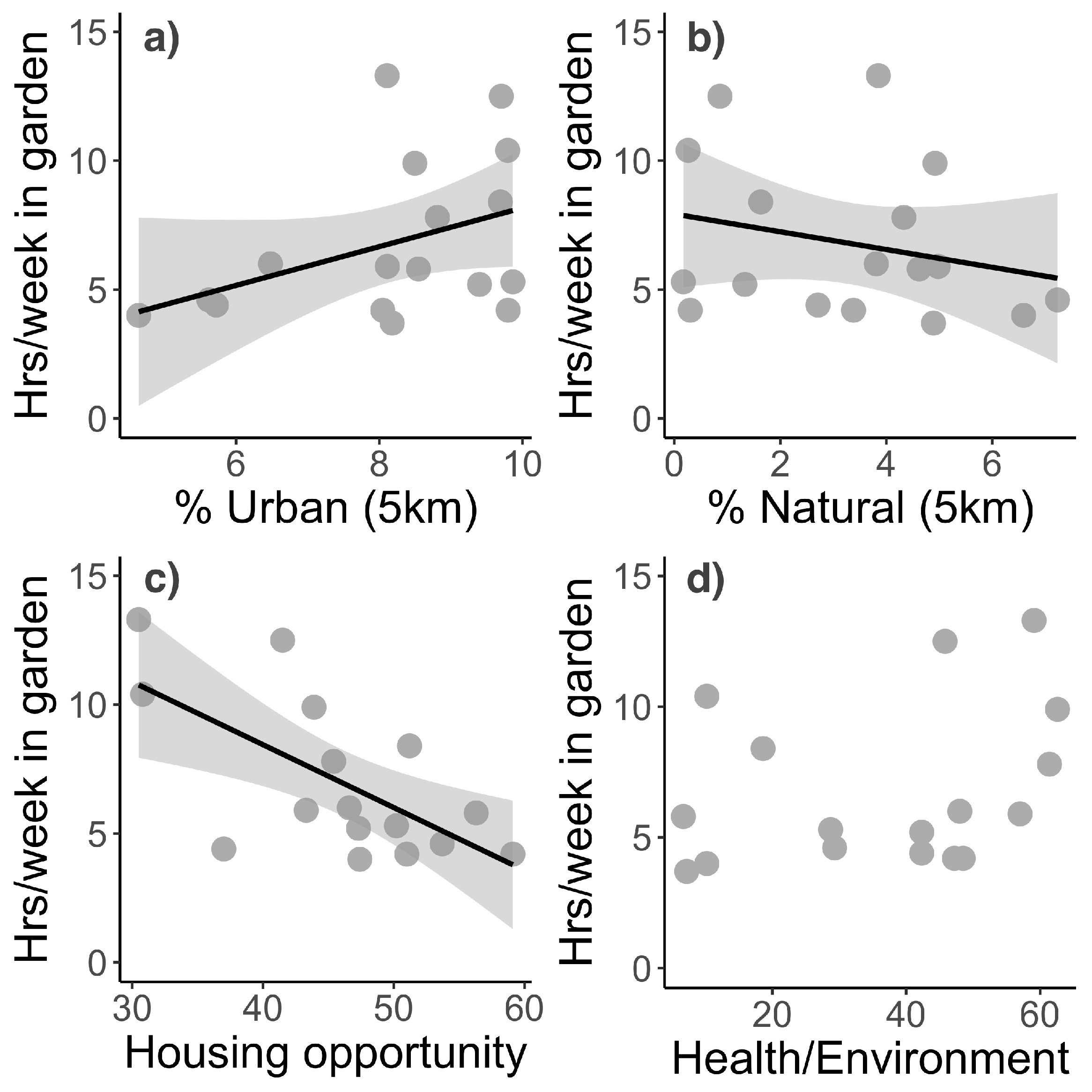Gardener Well-Being along Social and Biophysical Landscape Gradients
Abstract
:1. Introduction
2. Materials and Methods
2.1. Study System
2.2. Neighborhood Biophysical and Social Opportunity Data
2.3. Community Gardener Data
2.4. Data Analysis
3. Results
3.1. Self-Reported Well-Being
3.2. Self-Reported Garden Use
4. Discussion
5. Conclusions
Supplementary Materials
Acknowledgments
Author Contributions
Conflicts of Interest
References
- Grimm, N.B.; Faeth, S.H.; Golubiewski, N.E.; Redman, C.L.; Wu, J.; Bai, X.; Briggs, J.M. Global change and the ecology of cities. Science 2008, 319, 756–760. [Google Scholar] [CrossRef] [PubMed]
- Stocker, T.F.; Qin, D.; Plattner, G.-K.; Alexander, L.V.; Allen, S.K.; Bindoff, N.L.; Bréon, F.-M.; Church, J.A.; Cubasch, U.; Emori, S.; et al. Technical Summary. In Climate Change 2013: The Physical Science Basis; Contribution of Working Group I to the Fifth Assessment Report of the Intergovernmental Panel on Climate Change; Cambridge University Press: Cambridge, UK, 2013; pp. 33–115. [Google Scholar] [CrossRef]
- Kleerekoper, L.; Van Esch, M.; Salcedo, T.B. How to make a city climate-proof, addressing the urban heat island effect. Resour. Conserv. Recycl. 2012, 64, 30–38. [Google Scholar] [CrossRef]
- Gill, S.E.; Handley, J.F.; Ennos, A.R.; Pauleit, S. Adapting cities for climate change: The role of the green infrastructure. Built Environ. 2007, 33, 115–133. [Google Scholar] [CrossRef]
- Alexandri, E.; Jones, P. Temperature decreases in an urban canyon due to green walls and green roofs in diverse climates. Build. Environ. 2008, 43, 480–493. [Google Scholar] [CrossRef]
- Hartig, T.; Mitchell, R.; de Vries, S.; Frumkin, H. Nature and health. Annu. Rev. Public Health 2014, 35, 207–228. [Google Scholar] [CrossRef] [PubMed]
- Lee, A.C.K.; Maheswaran, R. The health benefits of urban green spaces: A review of the evidence. J. Public Health 2011, 33, 212–222. [Google Scholar] [CrossRef] [PubMed]
- Mitchell, R.; Popham, F. Effect of exposure to natural environment on health inequalities: An observational population study. Lancet 2008, 372, 1655–1660. [Google Scholar] [CrossRef]
- Jennings, V.; Gaither, C.J. Approaching environmental health disparities and green spaces: An ecosystem services perspective. Int. J. Environ. Res. Public Health 2015, 12, 1952–1968. [Google Scholar] [CrossRef] [PubMed]
- Rook, G.A. Regulation of the immune system by biodiversity from the natural environment: An ecosystem service essential to health. Proc. Natl. Acad. Sci. USA 2013, 110, 18360–18367. [Google Scholar] [CrossRef] [PubMed]
- Hanski, I.; Von Hertzen, L.; Fyhrquist, N.; Koskinen, K.; Torppa, K.; Laatikainen, T.; Karisola, P. Environmental biodiversity, human microbiota, and allergy are interrelated. Proc. Natl. Acad. Sci. USA 2012, 109, 8334–8339. [Google Scholar] [CrossRef] [PubMed]
- World Health Organization. Wellbeing Measures in Primary Health Care/The Depcare Project: Report on a WHO Meeting, Stockholm, Sweden, 12–13 February 1998. Available online: http://www.euro.who.int/__data/assets/pdf_file/0016/130750/E60246.pdf (accessed on 30 November 2017).
- Arnberger, A.; Allex, B.; Eder, R.; Ebenberger, M.; Wanka, A.; Kolland, F.; Wallner, P.; Hutter, H.P. Elderly resident’s uses of and preferences for urban green spaces during heat periods. Urban For. Urban Green. 2017, 21, 102–115. [Google Scholar] [CrossRef]
- Mees, H.L.P.; Driessen, P.P.J.; Runhaar, H.A.C. “Cool” governance of a “hot” climate issue: Public and private responsibilities for the protection of vulnerable citizens against extreme heat. Reg. Environ. Chang. 2015, 15, 1065–1079. [Google Scholar] [CrossRef]
- Lin, B.B.; Meyers, J.; Barnett, G. Understanding the potential loss and inequities of green space distribution with urban densification. Urban For. Urban Green. 2015, 14, 952–958. [Google Scholar] [CrossRef]
- Pauleit, S.; Ennos, R.; Golding, Y. Modeling the environmental impacts of urban land use and land cover change—A study in Merseyside, UK. Landsc. Urban Plan. 2005, 71, 295–310. [Google Scholar] [CrossRef]
- Heynen, N.; Perkins, H.A.; Roy, P. The political ecology of uneven urban green space: The impact of political economy on race and ethnicity in producing environmental inquality in MIlwaukee. Urban Aff. Rev. 2006, 42, 3–25. [Google Scholar] [CrossRef]
- Wen, M.; Zhang, X.; Croft, J.B. Spatial disparities in the distribution of parks and green spaces in the USA. Annu. Behav. Med. 2013, 45, 18–27. [Google Scholar] [CrossRef] [PubMed]
- Boone, C.G.; Buckley, G.L.; Grove, J.M.; Sister, C. Parks and people: An environmental justice inquiry in Baltimore, Maryland. Ann. Am. Assoc. Geogr. 2009, 99, 767–787. [Google Scholar] [CrossRef]
- Tooke, T.R.; Klinkenberg, B.; Coops, N.C. A geographical approach to identifying vegetation-related environmental equity in Canadian cities. Environ. Plan. B Plan. Des. 2010, 37, 1040–1056. [Google Scholar] [CrossRef]
- Astell-burt, T.; Feng, X.; Mavoa, S.; Badland, H.M.; Giles-corti, B. Do low-income neighbourhoods have the least green space? A cross-sectional study of Australia’s most populous cities. BMC Public Health 2014, 14, 19–21. [Google Scholar] [CrossRef] [PubMed] [Green Version]
- Jennings, V.; Floyd, M.F.; Shanahan, D.; Coutts, C.; Sinykin, A. Emerging issues in urban ecology: Implications for research, social justice, human health, and well-being. Popul. Environ. 2017, 39, 69–86. [Google Scholar] [CrossRef]
- Kingsley, J.Y.; Townsend, M.; Henderson-Wilson, C. Cultivating health and wellbeing: Members’ perceptions of the health benefits of a Port Melbourne community garden. Leis. Stud. 2009, 28, 207–219. [Google Scholar] [CrossRef]
- Guitart, D.; Pickering, C.; Byrne, J. Past results and future directions in urban community gardens research. Urban For. Urban Green. 2012, 11, 364–373. [Google Scholar] [CrossRef]
- Alaimo, K.; Packnett, E.; Miles, R.A.; Kruger, D.J. Fruit and vegetable intake among urban community gardeners. J. Nutr. Educ. Behav. 2008, 40, 94–101. [Google Scholar] [CrossRef] [PubMed]
- Wakefield, S.; Yeudall, F.; Taron, C.; Reynolds, J.; Skinner, A. Growing urban health: Community gardening in South-East Toronto. Health Promot. Int. 2007, 22, 92–101. [Google Scholar] [CrossRef] [PubMed]
- Armstrong, D. A survey of community gardens in upstate New York: Implications for health promotion and community development. Health Place 2000, 6, 319–327. [Google Scholar] [CrossRef]
- Wood, C.J.; Pretty, J.; Griffin, M. A case—Control study of the health and well-being benefits of allotment gardening. J. Public Health 2016, 38, e336–e344. [Google Scholar] [CrossRef] [PubMed]
- Kingsley, J.Y.; Townsend, M. “Dig In” to social capital: Community gardens as mechanisms for growing urban social connectedness. Urban Policy Res. 2006, 24, 525–537. [Google Scholar] [CrossRef]
- Glover, T.D.; Parry, D.C.; Shinew, K.J. Building relationships, accessing resources: Mobilizing social capital in community garden contexts. J. Leis. Res. 2005, 37, 450–474. [Google Scholar]
- Bell, S.; Fox-Kämper, R.; Keshavarz, N.; Benson, M.; Caputo, S.; Noori, S.; Voigt, A. Urban Allotment Gardens in Europe; Routledge: London, UK, 2016. [Google Scholar]
- Beilin, R.; Hunter, A. Co-constructing the sustainable city: How indicators help us “grow” more than just food in community gardens. Local Environ. 2011, 16, 523–538. [Google Scholar] [CrossRef]
- Teig, E.; Amulya, J.; Bardwell, L.; Buchenau, M.; Marshall, J.A.; Litt, J.S. Collective efficacy in Denver, Colorado: Strengthening neighborhoods and health through community gardens. Health Place 2009, 15, 1115–1122. [Google Scholar] [CrossRef] [PubMed]
- Cohen, N.; Reynolds, K. Resource needs for a socially just and sustainable urban agriculture system: Lessons from New York City. Renew. Agric. Food Syst. 2014, 30, 103–114. [Google Scholar] [CrossRef]
- Reynolds, K.; Cohen, N. Beyond the Kale: Urban Agriculture and Social Justice Activism in New York City; University of Georgia Press: Athens, GA, USA, 2016; Volume 28. [Google Scholar]
- Sullivan, W.C.; Kuo, F.E.; DePooter, S.F. The fruit of urban nature: Vital neighborhood spaces. Environ. Behav. 2004, 36, 678–700. [Google Scholar] [CrossRef]
- McWilliams, C. California: The Great Exception; University of California Press: Berkeley, CA, USA, 1999. [Google Scholar]
- Greenberg, M.; McKay, S. No Place Like Home; University of California, Santa Cruz: Santa Cruz, CA, USA, 2017; Available online: http://noplacelikehomeucsc.org/en/ (accessed on 1 December 2017).
- Parks, Recreation & Neighborhood Services, C. of S.J. Community Garden Plots. Available online: http://www.sanjoseca.gov/index.aspx?NID=599 (accessed on 5 November 2017).
- Brown, S.; Getz, C. Farmworker food insecurity and the production of hunger in California. In Cultivating Food Justice: Race, Class, and Sustainability (Food, Health, and the Environment); Alkon, A.H., Agyeman, J., Eds.; The MIT Press: Cambridge, MA, USA, 2011; pp. 121–146. [Google Scholar]
- Norkunas, M.K. The Politics of Public Memory: Tourism, History, and Ethnicity in Monterey, California; SUNY Press: Albany, NY, USA, 1993. [Google Scholar]
- Pellow, D.N.; Park, L.S.-H. The Silicon Valley of Dreams: Environmental Injustice, Immigrant Workers, and the High-Tech Global Economy; NYU Press: New York, NY, USA, 2002; ISBN 0814768172. [Google Scholar]
- Jin, S.; Yang, L.; Danielson, P.; Homer, C.; Fry, J.; Xian, G. A comprehensive change detection method for updating the National Land Cover Database to circa 2011. Remote Sens. Environ. 2013, 132, 159–175. [Google Scholar] [CrossRef]
- Environmental Systems Research Institute. ESRI ArcGIS Desktop: Release 10; Environmental Systems Research Institute: Redlands, CA, USA, 2010. [Google Scholar]
- Homer, C.G.; Dewitz, J.A.; Yang, L.; Jin, S.; Danielson, P.; Xian, G.; Coulston, J.; Herold, N.D.; Wickham, J.D.; Megown, K. Completion of the 2011 National Land Cover Database for the conterminous United States-Representing a decade of land cover change information. Photogramm. Eng. Remote Sens. 2015, 81, 345–354. [Google Scholar] [CrossRef]
- Cadenasso, M.L.; Pickett, S.T.A.; Schwarz, K.; Cadenassol, M.L.; Pickett, S.T.A.; Schwarz, K. Spatial heterogeneity in urban ecosystems: Reconceptualizing land cover and a framework for classification. Front. Ecol. Environ. 2007, 5, 80–88. [Google Scholar] [CrossRef]
- Center for Regional Change. Regional Opportunity Index; Center for Regional Change: Davis, CA, USA, 2015. [Google Scholar]
- United States Census Bureau. American Community Survey Data; United States Census Bureau: Suitland, MD, USA, 2014. Available online: http://factfinder.census.gov (accessed on 2 January 2018).
- Power, A.; Smyth, K. Heritage, health and place: The legacies of local community-based heritage conservation on social wellbeing. Health Place 2016, 39, 160–167. [Google Scholar] [CrossRef] [PubMed] [Green Version]
- Millennium Ecosystem Assessment. Ecosystems and Human Well-Being: Synthesis; Millennium Ecosystem Assessment: Washington, DC, USA, 2005; Volume 5. [Google Scholar]
- Lieber, E.; Weisner, T.; Taylor, J. Dedoose Software; Sociocultural Research Consultants: California, CA, USA, 2011. [Google Scholar]
- Oksanen, J. Multivariate Analysis of Ecological Communities in R; Vegan Tutorial; University Oulu: Oulu, Finland, 2015; pp. 1–40. [Google Scholar] [CrossRef]
- R Team. R Development Core Team. RA Lang. Environ. Stat. Comput. 2013, 55, 275–286. [Google Scholar]
- Calcagno, V.; Mazancourt, C. De glmulti: An R Package for easy automated model selection with (generalized) linear models. J. Stat. Softw. 2010, 34, 1–29. [Google Scholar] [CrossRef]
- Breheny, P.; Burchett, W. Visualizing Regression Models Using Visreg. 2012. Available online: http://myweb.uiowa.edu/pbreheny/publications/visreg.pdf (accessed on 13 November 2017).
- Algert, S.J.; Baameur, A.; Renvall, M.J. Vegetable output and cost savings of community gardens in San Jose, California. J. Acad. Nutr. Diet. 2014, 114, 1072–1076. [Google Scholar] [CrossRef] [PubMed]
- Tzoulas, K.; Korpela, K.; Venn, S.; Yli-pelkonen, V.; Ka, A.; Niemela, J.; James, P. Promoting ecosystem and human health in urban areas using green infrastructure: A literature review. Landsc. Urban Plan. 2007, 81, 167–178. [Google Scholar] [CrossRef]
- Firth, C.; Maye, D.; Pearson, D. Developing “community” in community gardens. Local Environ. 2011, 16, 555–568. [Google Scholar] [CrossRef]
- Gichunge, C.; Kidwaro, F. Utamu wa Afrika (the sweet taste of Africa): The vegetable garden as part of resettled African refugees’ food environment. Nutr. Diet. 2014, 71, 270–275. [Google Scholar] [CrossRef]
- Krasny, M.E.; Tidball, K.G. Community gardens as contexts for science, stewardship, and civic action learning. Cities Environ. 2009, 2, 1–18. [Google Scholar] [CrossRef]
- Okvat, H.A.; Zautra, A.J. Community gardening: A parsimonious path to individual, community, and environmental resilience. Am. J. Community Psychol. 2011, 47, 374–387. [Google Scholar] [CrossRef] [PubMed]
- Lin, B.B.; Gaston, K.J.; Fuller, R.A.; Wu, D.; Bush, R.; Shanahan, D.F. How green is your garden?: Urban form and socio-demographic factors influence yard vegetation, visitation, and ecosystem service benefits. Landsc. Urban Plan. 2017, 157, 239–246. [Google Scholar] [CrossRef]
- Saldivar-Tanaka, L.; Krasny, M.E. Culturing community development, neighborhood open space, and civic agriculture: The case of Latino community gardens in New York City. Agric. Hum. Values 2004, 21, 399–412. [Google Scholar] [CrossRef]
- Baker, L.E. Tending cultural landscapes and food citizenship in Toronto’s community gardens. Geogr. Rev. 2004, 94, 305–325. [Google Scholar] [CrossRef]
- Campbell, L.; Wiesen, A. Restorative Commons: Creating Health and Well-Being through Urban Landscapes; Department of Agriculture, Forest Service, Northern Research Station: Newtown Square, PA, USA, 2011. [Google Scholar]
- Blunsdon, B.; Davern, M. Measuring wellness through interdisciplinary community development: Linking the physical, economic and social environment. J. Community Pract. 2007, 15, 217–238. [Google Scholar] [CrossRef]
- Florida, R. The New Urban Crisis: How Our Cities Are Increasing Inequality, Deepening Segregation, and Failing the Middle Class—And What We Can Do about It; Basic Books: New York, NY, USA, 2017. [Google Scholar]
- Eigenbrod, F.; Bell, V.A.; Davies, H.N.; Heinemeyer, A.; Armsworth, P.R.; Gaston, K.J. The impact of projected increases in urbanization on ecosystem services. Proc. R. Soc. B Biol. Sci. 2011. [Google Scholar] [CrossRef] [PubMed]
- Flocks, J.; Escobedo, F.; Wade, J.S.; Varela, S.; Wald, C. Environmental justice implications of urban tree cover in Miami-Dade County, Florida. Environ. Justics 2011, 4, 125–134. [Google Scholar] [CrossRef]
- Jenerette, G.D.; Harlan, S.L.; Stefanov, W.L.; Martin, C.A. Ecosystem services and urban heat riskscape moderation: Water, green spaces, and social inequality in Phoenix, USA. Ecol. Appl. 2011, 21, 2637–2651. [Google Scholar] [CrossRef] [PubMed]
- Middle, I.; Dzidic, P.; Buckley, A.; Bennett, D.; Tye, M.; Jones, R. Integrating community gardens into public parks: An innovative approach for providing ecosystem services in urban areas. Urban For. Urban Green. 2012, 13, 638–645. [Google Scholar] [CrossRef]



| Opportunity Domain | Neighborhood Assessment | ACS Indicators |
|---|---|---|
| Economy | Neighborhood job and business climate | Job Availability (#), Job Quality (%), Job Growth (%), Bank Accessibility (#), Business Growth (%) |
| Housing | Neighborhood availability of sufficient and affordable housing | Housing Adequacy (%), Housing Affordability (ratio) |
| Health/environmental quality | Neighborhood health care access and health of the environment | Prenatal Care (%), Distance to Supermarket (%), Health Care Availability (#), Air Quality (PM2.5) |
| Civic life | Neighborhood social and political stability | Neighborhood Stability (%), US Citizenship (%) |
| Education | Neighborhood provision of educational needs and education quality | High School Graduation Rate (%), UC/CSU Eligibility (%), Teacher Experience (%), High School Discipline Rate (%) |
| Measure | % Natural | % Open | % Urban | % Agriculture | Education | Economy | Housing | Health/Environmental Quality | Civic Life |
|---|---|---|---|---|---|---|---|---|---|
| Min | 0.0 | 5.4 | 12.0 | 0.0 | 38.3 | 10.6 | 30.5 | 6.7 | 69.7 |
| Max | 52.3 | 19.7 | 94.4 | 37.0 | 64.0 | 21.8 | 59.1 | 62.6 | 90.9 |
| Mean | 15.8 | 12.5 | 50.2 | 4.7 | 51.1 | 15.5 | 45.6 | 38.1 | 80.0 |
| SD | 15.0 | 4.6 | 32.0 | 11.3 | 7.8 | 2.7 | 7.9 | 20.2 | 6.8 |
| Social Opportunity | Df | Sum of Sqs | Mean Sqs | F | R2 | p |
|---|---|---|---|---|---|---|
| Education | 1 | 0.07 | 0.07 | 1.06 | 0.06 | 0.40 |
| Housing | 1 | 0.05 | 0.05 | 0.72 | 0.04 | 0.68 |
| Health/Environmental quality | 1 | 0.03 | 0.02 | 0.36 | 0.02 | 0.92 |
| Civic life | 1 | 0.09 | 0.09 | 1.33 | 0.08 | 0.26 |
| Biophysical Landscape | ||||||
| Urban | 1 | 0.08 | 0.08 | 1.23 | 0.07 | 0.27 |
| Agriculture | 1 | 0.12 | 0.12 | 1.96 | 0.11 | 0.06 |
| Open | 1 | 0.10 | 0.10 | 1.57 | 0.09 | 0.15 |
| Natural | 1 | 0.08 | 0.08 | 1.20 | 0.07 | 0.33 |
© 2018 by the authors. Licensee MDPI, Basel, Switzerland. This article is an open access article distributed under the terms and conditions of the Creative Commons Attribution (CC BY) license (http://creativecommons.org/licenses/by/4.0/).
Share and Cite
Egerer, M.H.; Philpott, S.M.; Bichier, P.; Jha, S.; Liere, H.; Lin, B.B. Gardener Well-Being along Social and Biophysical Landscape Gradients. Sustainability 2018, 10, 96. https://doi.org/10.3390/su10010096
Egerer MH, Philpott SM, Bichier P, Jha S, Liere H, Lin BB. Gardener Well-Being along Social and Biophysical Landscape Gradients. Sustainability. 2018; 10(1):96. https://doi.org/10.3390/su10010096
Chicago/Turabian StyleEgerer, Monika H., Stacy M. Philpott, Peter Bichier, Shalene Jha, Heidi Liere, and Brenda B. Lin. 2018. "Gardener Well-Being along Social and Biophysical Landscape Gradients" Sustainability 10, no. 1: 96. https://doi.org/10.3390/su10010096





